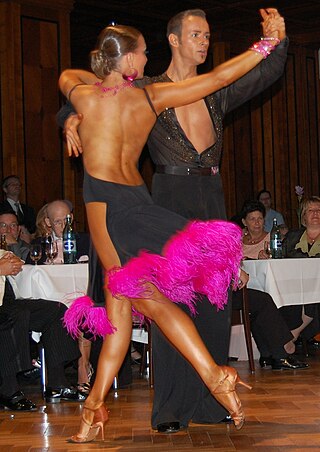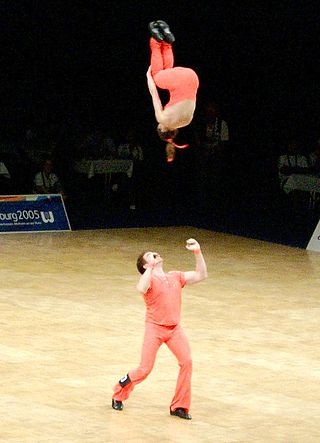Related Research Articles

Ballroom dance is a set of partner dances, which are enjoyed both socially and competitively around the world, mostly because of its performance and entertainment aspects. Ballroom dancing is also widely enjoyed on stage, film, and television.

East Coast Swing (ECS) is a form of social partner dance. It belongs to the group of swing dances. It is danced under fast swing music, including rock and roll and boogie-woogie.

The waltz, meaning "to roll or revolve") is a ballroom and folk dance, normally in triple, performed primarily in closed position.
West Coast Swing is a partner dance with roots in the Lindy Hop. It is characterized by an elastic look that results from its extension-compression technique of partner connection and is danced primarily in a slotted area on the dance floor. The dance allows for both partners to improvise steps while dancing together, putting West Coast Swing in a short list of dances that emphasize improvisation.

Swing dance is a group of social dances that developed with the swing style of jazz music in the 1920s–1940s, with the origins of each dance predating the popular "swing era". Hundreds of styles of swing dancing were developed; those that have survived beyond that era include Lindy Hop, Balboa, Collegiate Shag, and Charleston. Today, the best-known of these dances is the Lindy Hop, which originated in Harlem in the early 1930s. While the majority of swing dances began in African American communities as vernacular African American dances, some influenced swing-era dances, like Balboa, developed outside of these communities.
Jive may refer to:
Jump blues is an up-tempo style of blues, usually played by small groups and featuring horn instruments. It was popular in the 1940s and was a precursor of rhythm and blues and rock and roll. Appreciation of jump blues was renewed in the 1990s as part of the swing revival.
The music of Louisiana can be divided into three general regions: rural south Louisiana, home to Creole Zydeco and Old French, New Orleans, and north Louisiana. The region in and around Greater New Orleans has a unique musical heritage tied to Dixieland jazz, blues, and Afro-Caribbean rhythms. The music of the northern portion of the state starting at Baton Rouge and reaching Shreveport has similarities to that of the rest of the US South.
Modern Jive is a dance style derived from swing, Lindy Hop, rock and roll, salsa and others, the main difference being the simplification of footwork by removing syncopation such as chasse. The term "French Jive" is occasionally used instead, reflecting the origins of the style, as is the term "Smooth Jive". The word "modern" distinguishes it from ballroom Jive.
Ceroc is an international dance club with more than 200 venues across the UK as well as national and regional competitions and weekend events throughout the year. It also has franchises in many other countries in Europe, Asia and the Antipodes.

Partner dances are dances whose basic choreography involves coordinated dancing of two partners, as opposed to individuals dancing alone or individually in a non-coordinated manner, and as opposed to groups of people dancing simultaneously in a coordinated manner.
Since the early 1970s, Brittany has experienced a tremendous revival of its folk music. Along with flourishing traditional forms such as the bombard-biniou pair and fest-noz ensembles incorporating other additional instruments, it has also branched out into numerous subgenres.

Acrobatic rock'n'roll is a very athletic, competitive form of partner dance that originated from lindy hop. Unlike lindy hop, however, it is a choreographed dance designed for performance. It is danced by both couples and groups, either all-female or four to eight couples together. This is normally a very fast and physically demanding dance.

The history of Lindy Hop begins in the African American communities of Harlem, New York during the late 1920s in conjunction with swing jazz. Lindy Hop is closely related to earlier African American vernacular dances but quickly gained its own fame through dancers in films, performances, competitions, and professional dance troupes. It became especially popular in the 1930s with the upsurge of aerials. The popularity of Lindy Hop declined after World War II, and it converted to other forms of dancing, but it never disappeared during the decades between the 1940s and the 1980s until European and American dancers revived it starting from the beginning of the 1980s.

Dance music is music composed specifically to facilitate or accompany dancing. It can be either a whole musical piece or part of a larger musical arrangement. In terms of performance, the major categories are live dance music and recorded dance music. While there exist attestations of the combination of dance and music in ancient times, the earliest Western dance music that we can still reproduce with a degree of certainty are old fashioned dances. In the Baroque period, the major dance styles were noble court dances. In the classical music era, the minuet was frequently used as a third movement, although in this context it would not accompany any dancing. The waltz also arose later in the classical era. Both remained part of the romantic music period, which also saw the rise of various other nationalistic dance forms like the barcarolle, mazurka, ecossaise, ballade and polonaise.
Swedish Dancesport Federation (DSF) administers all dancesport in Sweden. The association was formed on February 25, 1968, and is one of 68 different sports federations in Sweden. DSF became a member of the Swedish Sports Confederation (RF) in 1977, which administers all sports in Sweden. Apart from this membership Swedish Dancesport Federation also is a member of the International Dancesport Federation (IDSF) from June 19, 2011 known as the World DanceSport Federation (WDSF) and the World Rock'n'Roll Confederation (WRRC). The office lies in Farsta, Stockholm.

Alan R. White, is an American Top 40 disc jockey, pioneering nightclub DJ, booking agent, talent manager, record producer, disco innovator, nightclub operator and promoter, radio and television personality, dance event promoter, an internet broadcasting pioneer, and author.

Music in the city of Paris, France, includes a variety of genres, from opera and symphonic music to musical theater, jazz, rock, rap, hip-hop, the traditional Bal-musette and gypsy jazz, and every variety of world music, particularly music from Africa and North Africa. such as the Algerian-born music known as Raï. Leading musical institutions include the Paris Opera, the Orchestre de Paris, and the Paris Conservatory, the first state music conservatory in Europe. The Cité de la Musique at La Villette is home of the new Paris Symphony Hall, the Conservatory, a museum of musical instruments, and Le Zenith, a major venue for popular music. Many of the churches in Paris have magnificent historic organs, and often host concerts. The city is also known for its music halls and clubs.
References
- ↑ Michel Ange Lau: "Dance Manual", "The History". 1996 "Modernjive.Com - History]
- ↑ The LeRoc Federation: Information about LeRoc "Information". Archived from the original on 2008-02-21. Retrieved 2008-02-23.
- ↑ Michel Ange Lau: "Dance Manual", "The History". 1996 "Modernjive.Com - History]
- ↑ "Ceroc & LeRoc" HowtoJive.com - Ceroc & LeRoc
- ↑ Michel Ange Lau: "Dance Manual", "The History". 1996 "Modernjive.Com - History]